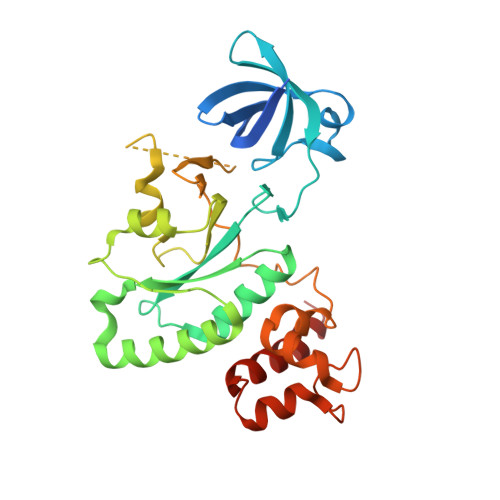The Stringent Response Inhibits 70S Ribosome Formation in Staphylococcus aureus by Impeding GTPase-Ribosome Interactions.
Bennison, D.J., Nakamoto, J.A., Craggs, T.D., Milon, P., Rafferty, J.B., Corrigan, R.M.(2021) mBio 12: e0267921-e0267921
- PubMed: 34749534
- DOI: https://doi.org/10.1128/mBio.02679-21
- Primary Citation of Related Structures:
6ZHL, 6ZHM, 6ZJO - PubMed Abstract:
During nutrient limitation, bacteria produce the alarmones (p)ppGpp as effectors of a stress signaling network termed the stringent response. RsgA, RbgA, Era, and HflX are four ribosome-associated GTPases (RA-GTPases) that bind to (p)ppGpp in Staphylococcus aureus. These enzymes are cofactors in ribosome assembly, where they cycle between the ON (GTP-bound) and OFF (GDP-bound) ribosome-associated states. Entry into the OFF state occurs upon hydrolysis of GTP, with GTPase activity increasing substantially upon ribosome association. When bound to (p)ppGpp, GTPase activity is inhibited, reducing 70S ribosome assembly and growth. Here, we determine how (p)ppGpp impacts RA-GTPase-ribosome interactions. We show that RA-GTPases preferentially bind to 5'-diphosphate-containing nucleotides GDP and ppGpp over GTP, which is likely exploited as a regulatory mechanism within the cell to shut down ribosome biogenesis during stress. Stopped-flow fluorescence and association assays reveal that when bound to (p)ppGpp, the association of RA-GTPases to ribosomal subunits is destabilized, both in vitro and within bacterial cells. Consistently, structural analysis of the ppGpp-bound RA-GTPase RsgA reveals an OFF-state conformation similar to the GDP-bound state, with the G2/switch I loop adopting a conformation incompatible with ribosome association. Altogether, we highlight (p)ppGpp-mediated inhibition of RA-GTPases as a major mechanism of stringent response-mediated ribosome assembly and growth control. IMPORTANCE The stringent response is a bacterial signaling network that utilizes the nucleotides pppGpp and ppGpp to reprogram cells in order to survive nutritional stresses. However, much about how these important nucleotides control cellular reprogramming is unknown. Our previous work revealed that (p)ppGpp can bind to and inhibit the enzymatic activity of four ribosome-associated GTPases (RA-GTPases), enzymes that facilitate maturation of the 50S and 30S ribosomal subunits. Here, we examine how this occurs mechanistically and demonstrate that this interaction prevents the accommodation of RA-GTPases on ribosomal subunits both in vitro and within bacterial cells, with the ppGpp-bound state structurally mimicking the inactive GDP-bound conformation of the enzyme. We additionally reveal that these GTPase enzymes have a greater affinity for OFF-state-inducing nucleotides, which is a mechanism likely to control ribosome assembly during growth. With this, we further our understanding of how ribosome function is controlled by (p)ppGpp, enabling bacterial survival during stress.
Organizational Affiliation:
The Florey Institute, Department of Molecular Biology and Biotechnology, University of Sheffieldgrid.11835.3e, Sheffield, United Kingdom.


















